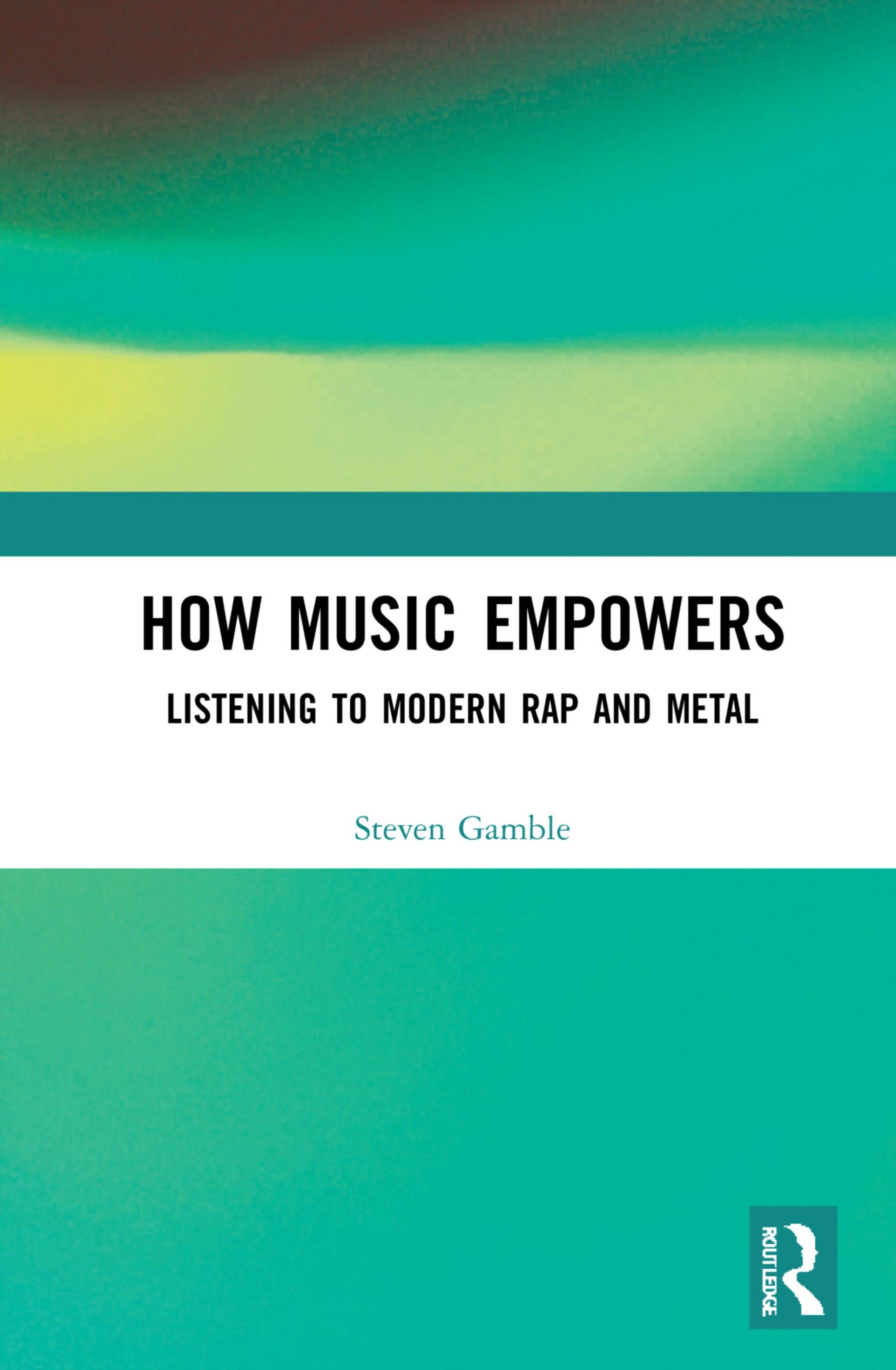Chapters
Click on any of the chapter headings to find out more.
1. Introduction
2. Listening to popular music in everyday life: an ecological-embodied approach
3. Individual empowerment in rap and metal music listening
4. Music as a lifeline: listening for resilience
5. The empowerment of popular music communities
6. Can music change the world? Empowerment, politics, and social change
7. Conclusion
Introduction
This introductory chapter establishes the study of empowerment in rap and metal listening, situating it at the intersection of several key ideas: listening, the body, perception, cognition, the environment, identity, and community. It discusses the social contexts of rap and metal music and culture, describing how they are viewed by political institutions and academic disciplines. The chapter then addresses four major subjects: analysis, power, empowerment, and affordance. The section on analysis establishes how music theory and interpretation will be applied to a sample of metal and rap songs. Next, there is a critique of the predominant sociological approach to power. A discussion of empowerment explains how the book will instead examine listener experience using broadly psychological theories of power. Finally, the chapter introduces an ecological perspective that attends to subjectivity, meaning, the body, and environmental context in experiences of music listening. Chapter 1 ends with an overall outline of the book, which sets out the different topics under investigation in each chapter: listening, individual empowerment, resilience, communal empowerment, and social change.
Listening to popular music in everyday life: an ecological-embodied approach
Chapter 2
Listening to popular music in everyday life: an ecological-embodied approach
Focusing on listening as an active process, this chapter develops an experiential approach to popular music listening. This chapter largely supports postmodernist and poststructuralist views of musical meaning, sharing with them a sensitivity to subjectivity, embodiment, meaning, listening context, and individual identity. However, the approach adopted here can also be used to generalise about listening experiences because it is based upon interactionist and schematic principles which underlie perception and cognition, drawn from two major research traditions on everyday human experience: the ecological theory of perception (formulated by James J. and Eleanor Gibson) and embodied cognition (particularly the cognitive linguistics and philosophy of George Lakoff and Mark Johnson). The chapter provides an important review of the ecological and embodied theories of perception and meaning that have increasingly featured in music studies since the 1990s, with an emphasis on inviting cooperation between disparate research perspectives. It concludes by considering the significance of music style (and style competence) to experiences of popular music listening.
Chapter 3
Individual empowerment in rap and metal music listening
This chapter develops a theory of individual empowerment based in experiences of listening to rap and metal music. It introduces three psychological theories that can be used to investigate how individuals are affected in the listening process: approach/inhibition theory, which examines behaviour; the personal sense of power, which relates to affect and self-esteem; and the processes of mentalising and mirroring, which address interpretation and state of mind. Following an account of Allan Moore’s theory of the personic environment, five music analyses are provided to demonstrate the potential for empowering listening experiences in action. The chapter considers the relationship between the genres of rap and metal and ends with analysis of a track that combines them stylistically (although not exactly in the most common tradition of ‘rap metal’).
Little Simz © Frank Schwichtenberg / CC BY-SA 4
Ensiferum © Stefan Bollmann / CC BY-SA 4
Chapter 4
Music as a lifeline: listening for resilience
Extending the model of listener empowerment developed throughout the book thus far, this chapter addresses ideas and conceptual metaphors of music as a survival mechanism. It considers the effects of music on individual health and wellbeing through narratives that emerge in rap and metal listening, with reference to the fields of music psychology and music therapy. The chapter focuses on the idea of resilience, a term which is closely related to empowerment (and similarly a victim of ambiguity and appropriation). Alongside music analysis, digital ethnography is employed to examine the beliefs of listeners who use the Internet to describe their interpretations of songs. Observing the varied narratives of rap and metal prompts a discussion of the realism and fantasy of each genre, with consequences for how relatable such experiences of music listening really are. Looking beyond the potential for individual resilience and towards affordances of collective resistance, the chapter concludes with analysis of a track that combines two of the most contemporary styles of metal and rap: djent and grime.
A Day To Remember © Stefan Brending / CC-by-sa-3.0 de
Chapter 5
The empowerment of popular music communities
Developing upon ideas of individual experience, this chapter engages with experiences of communality in listening to rap and metal. It builds on the model of individual empowerment to uncover how communities can be imagined through listening. Untangling several terms for collectives that have been used to study rap and metal – among them subculture, scene, and community – the chapter considers the potential for empowering solidarities experienced through musical and social interaction. An introduction to the field of community psychology is then interlaced between analyses of four songs. The chapter argues that the principles and practices of this field are pertinent to the study of music communities, particularly how scholars and activists approach the process of empowerment. Raphael Travis’ Individual and Community Empowerment framework is adopted to demonstrate dimensions of empowerment, further nuancing understandings of what, exactly, individuals and communities gain from their listening. Looking beyond communal experience specific to listening, the chapter elaborates on individual behaviour to examine cultural engagement through fandom, addressing two examples of digital music communities.
Chapter 6
Can music change the world? Empowerment, politics, and social change
This chapter analyses the cultural politics of empowerment, tracing how the meanings of the term have been contested and transformed since it entered popular use in the 1980s. Changes in the way that the term has been employed over the last thirty years obscure the relationship between liberating effects (such as equality and justice) and neoliberal pressures (including responsibility and personal agency) in the fields of social work, international development, and feminism. Applying this finding to rap and metal, the chapter critically examines the widespread belief that music can incite social change. It completes the argument (made in previous chapters) that music can affect individuals in the course of their listening by considering how this manifests as social action. It therefore reaches a conclusion on the relationship of empowerment to power. The analysis of four rap and metal songs demonstrates how music can be heard to instil a social awareness and inspire listeners to partake in social activism. Taking influence from the contested contemporary notion of women’s empowerment (for one example), the chapter culminates in a discussion of the effects music really can have on our lives.
Conclusion
This brief conclusive chapter recaps the journey taken through the book, concisely reiterating the import of ecological perception, embodied cognition, music style, approach/inhibition theory, the personal sense of power, mentalising and mirroring, the personic environment, resilience, community, scene, fandom, community psychology, social change, power, and empowerment. The chapter also draws additional conclusions in relation to the role of the voice, virtual distance (proxemics), lyrics, violence, and disempowerment. Laying the groundwork for further studies, potential extensions of the empowerment model are discussed, including applications to different genres (such as punk, R&B, rock, electronic dance music, and pop), video and multimedia, and different practices of musicking. The chapter also suggests the theoretical relevance and possible routes of development for psychologists, sociologists, and ethnographers. The book ends with two final song analyses that emphasise the author’s own listening experiences then significant sociopolitical impacts, applying the entire theoretical model in order to demonstrate what can be gained by studying empowerment in experiences of listening.




